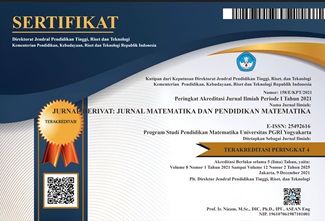Aplikasi Triple Exponential Smoothing Untuk Forecasting Jumlah Penduduk Miskin
DOI:
https://doi.org/10.31316/j.derivat.v3i2.719Abstract
This study aims to predict the number of poor in Indonesia for the next few years using a triple exponential smoothing method.
The purpose of this research is the result of the forecast number of poor people in Indonesia accurate forecast results are used as an alternative data the government for consideration of government to determine the direction of national poverty reduction policies. This research includes the study of literature research, by applying the theory of forecasting to generate predictions of poor people for coming year. Furthermore, analyzing the mistakes of the methods used in terms of the count: Mean Absolute Deviation (MAD), Mean Square Error (MSE), Mean absolute percentage error (MAPE) and Mean Percentage Error (MPE). The function of this error analysis is to measure the accuracy of forecasting results that have been conducted.
These results indicate that the number of poor people in 2017 amounted to 24,741,871 inhabitants, in 2018 amounted to 24,702,928 inhabitants, in 2019 amounted to 24,638,022 inhabitants and in 2020 amounted to 24,547,155 people. The forecasting results show an average reduction in the number of poor people in Indonesia last five years (2016-2020 years) ranges from 0.16 million. Analysis forecasting model obtained an mean absolute deviation (MAD) obtained by 0.246047. Mean squared error (MSE) of forecasting results with the original data by 1.693277. Mean absolute percentage error (MAPE) of 3.040307% and the final Mean percentage error (MPE) of 0.888134%.
Kata Kunci: Forecasting, Triple Exponential SmoothingDownloads
Published
Issue
Section
Citation Check
License
Authors who publish with this journal agree to the following terms:
-
Authors retain copyright and grant the journal right of first publication with the work simultaneously licensed under a Creative Commons Attribution-ShareAlike 4.0 International License that allows others to share the work with an acknowledgment of the work's authorship and initial publication in this journal.
- Authors are able to enter into separate, additional contractual arrangements for the non-exclusive distribution of the journal's published version of the work (e.g., post it to an institutional repository or publish it in a book), with an acknowledgment of its initial publication in this journal.
- Authors are permitted and encouraged to post their work online (e.g., in institutional repositories or on their website) prior to and during the submission process, as it can lead to productive exchanges, as well as earlier and greater citation of published work (See The Effect of Open Access).







